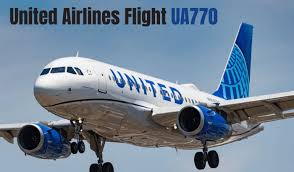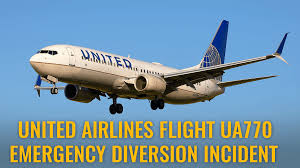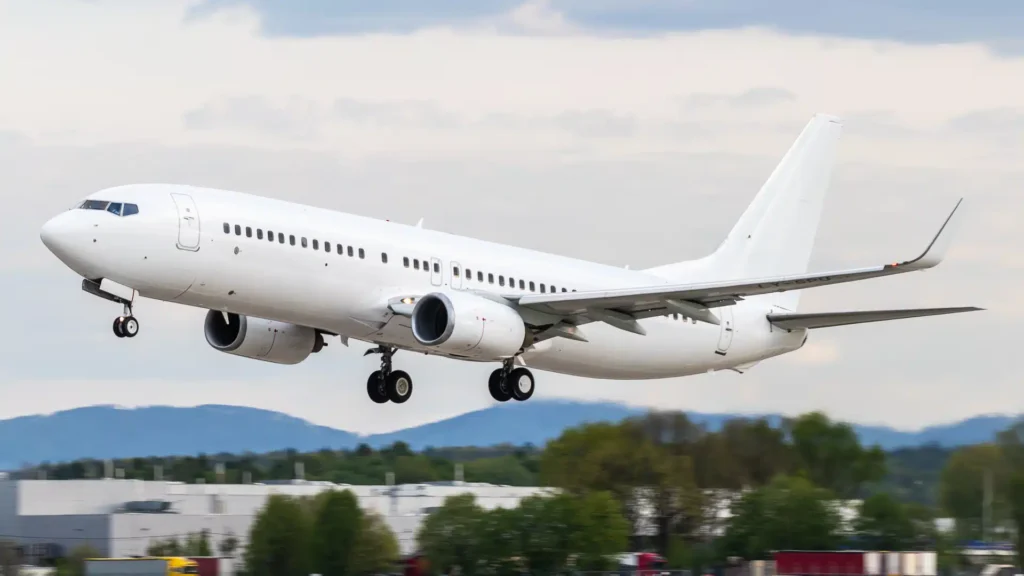
The United Airlines Flight UA770 emergency diversion has captured global attention, raising serious questions about aviation safety, emergency protocols, and airline crisis management. Onboard passengers witnessed what could only be described as a terrifying experience, as their routine flight was suddenly rerouted midair due to an unexpected emergency.
In this detailed report, we explore what happened during the UA770 flight, how the crew responded, what officials have said since the incident, and what this means for future airline travel.
Overview of the United Airlines Flight UA770 Incident
On a seemingly regular day, United Airlines Flight UA770 departed from its scheduled origin with passengers expecting a smooth journey. But what started as a normal flight quickly turned into a tense and chaotic event, forcing the aircraft to make an emergency diversion to the nearest available airport.
Initial reports state that UA770 was en route from Denver International Airport (DEN) to Orlando International Airport (MCO). The aircraft, a Boeing 737, was cruising at a stable altitude when an onboard emergency occurred, leading the pilot to declare a midair emergency and request immediate clearance to divert.
The Sequence of Events Leading to the Emergency Diversion
According to official air traffic control logs and eyewitness accounts from passengers, the event unfolded rapidly. Roughly two hours into the flight, passengers noticed unusual sounds and movements. The captain then made an announcement, informing travelers that the flight would be diverted due to an unspecified issue.
Several reports mention a medical emergency involving a passenger, though United Airlines has not officially confirmed this detail. Some speculate it was a mechanical fault, possibly related to cabin pressure or engine temperature. Regardless, the situation was serious enough to require the pilot’s urgent action and to activate emergency landing protocols.
Emergency Landing Location and Response

The flight made a safe landing at George Bush Intercontinental Airport in Houston, Texas, where emergency personnel, including paramedics and airport security, were already positioned and awaiting arrival. The entire landing process was handled swiftly, with the aircraft guided to a secure bay for inspection and passenger disembarkation.
Eyewitnesses at the airport reported seeing multiple ambulances and emergency vehicles near the tarmac. United Airlines Flight UA770’s emergency diversion was handled efficiently by ground control and airport personnel, reflecting the preparedness of both the airline and the airport for unexpected incidents.
Passenger Reactions and Onboard Experience
Passengers took to social media soon after the event, sharing their experiences. Many expressed relief that the crew handled the emergency with professionalism and calmness. One passenger tweeted:
“Scariest flight of my life. Thankful for the UA770 crew who acted fast and got us on the ground safely. Still shaken.”
Others praised the pilot’s quick decision-making and the crew’s communication during the event. Some shared photos and videos of emergency responders approaching the aircraft after landing.
The atmosphere inside the cabin, as described by several passengers, was tense but orderly. The crew followed standard emergency protocols—checking on passengers, securing the cabin, and preparing for landing. Oxygen masks were not deployed, indicating that cabin pressure loss was likely not the issue, though this remains unconfirmed.
United Airlines’ Official Statement
United Airlines released a brief official statement following the emergency diversion:
“United Flight UA770 from Denver to Orlando diverted to Houston out of an abundance of caution due to an onboard situation. The aircraft landed safely, and all passengers deplaned without further incident. We thank our crew for their professionalism and quick response. Passengers were rebooked and accommodations were arranged where necessary.”
The airline did not specify the nature of the emergency, citing privacy concerns and ongoing internal investigation. However, industry analysts believe the lack of oxygen mask deployment and absence of structural damage suggest the issue may have been either a passenger medical emergency or a minor technical anomaly.
FAA and NTSB Involvement
The Federal Aviation Administration (FAA) confirmed it was aware of the incident and had opened a preliminary review, which is standard procedure for any unscheduled emergency landing. As of now, the National Transportation Safety Board (NTSB) has not launched a formal investigation, indicating that no major mechanical or systemic failure was reported.
However, both agencies will likely request cockpit voice recordings (CVR) and flight data recordings (FDR) to determine the cause behind the United Airlines Flight UA770 emergency diversion. These investigations, although routine, are critical to ensuring transparency and preventing future incidents.
Aircraft Specifications and Safety Record

The aircraft involved was a Boeing 737-800, a widely used and relatively modern aircraft known for its solid safety track record. The specific aircraft had reportedly passed its most recent maintenance checks and inspections, according to FAA data available to the public.
United Airlines has historically maintained a high standard of safety and ranks among the top U.S. airlines for safety compliance. The handling of Flight UA770’s emergency diversion seems to reinforce this reputation, as the airline’s crew followed procedures correctly and ensured a safe outcome for all on board.
Impact on Passengers and Travel Plans
While all passengers were safe, the emergency diversion disrupted travel plans significantly. Some passengers missed connecting flights, others had to stay overnight in Houston while waiting for rebooking.
United Airlines offered:
- Full rebooking assistance
- Meal vouchers for delayed passengers
- Hotel accommodations for overnight stays
- Compensation in the form of travel credit for affected travelers
Most passengers reportedly appreciated the quick response and support, although a few criticized the lack of immediate information during the diversion process. Clear and consistent communication during emergencies is an area many airlines continue to work on improving.
Social Media and Media Coverage
The United Airlines Flight UA770 emergency diversion trended on X (formerly Twitter) for several hours after the incident, with major news outlets picking up the story. Hashtags such as #UA770, #UnitedAirlines, and #EmergencyLanding were used by thousands of users.
Media outlets including CNN, Reuters, and local Houston news stations covered the story in their afternoon and evening news segments. Aviation bloggers and analysts also weighed in, analyzing radar flight paths and aircraft performance data to piece together what could have triggered the diversion.
Industry Expert Opinions
Aviation experts largely agree that the flight crew acted correctly. Former commercial pilot and aviation analyst David Mullen stated:
“Anytime a pilot declares an emergency and diverts, it’s for a valid reason. Whether mechanical, medical, or otherwise, they’re trained to prioritize safety above all else.”
He added that emergency diversions like UA770’s are relatively rare but not unprecedented. Modern aircraft systems and crew training are designed to handle such scenarios with precision and caution.
Psychological and Emotional Impact
While there were no physical injuries reported, the psychological impact on passengers shouldn’t be overlooked. Sudden diversions can trigger anxiety, panic attacks, and trauma—especially for those with a fear of flying. Mental health experts recommend airlines provide optional counseling support following such incidents.
United Airlines included mental health hotline numbers in post-event communication to passengers, showing an awareness of the broader emotional toll that midair emergencies can create.
Looking Forward: What This Means for Air Travel
The United Airlines Flight UA770 emergency diversion is a reminder that air travel, while statistically very safe, can still involve unexpected events. It highlights the importance of:
- Ongoing pilot and crew training
- Aircraft maintenance and monitoring systems
- Transparent communication with passengers
- Efficient emergency response coordination between airline and airport staff
As travel resumes post-pandemic and passenger numbers rise, airlines must continue investing in technologies and protocols that reduce risk and ensure immediate responses during emergencies.
Final Thoughts
The United Airlines Flight UA770 emergency diversion could have been a disaster—but thanks to skilled crew members, trained ground staff, and proper emergency protocols, it ended with every passenger safely on the ground. While the full cause of the diversion remains under investigation, the professionalism displayed by all involved sends a reassuring message to the flying public.
Emergencies can happen, but what truly matters is how they’re handled. In this case, United Airlines has once again proven why it remains a trusted name in aviation. For now, passengers can feel a little more confident knowing that—even when the unexpected happens—safety still comes first.




